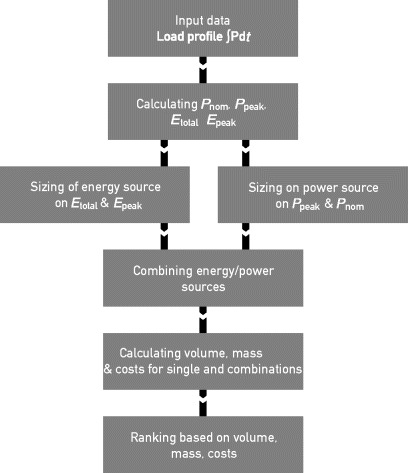D.3 Power Source Selection Tool Method
D.3.1 First Approach
In Section D.2, different tools and methods were presented. Most of them are either used by the institute itself (e.g., POWER) or not implemented (e.g., the CES database of power sources). The methods described by Cook and Sastry (2005) and Fu et al. (2005) are both interesting solutions to the problems that industrial design engineers face when making a choice for a power source during the concept phase. In this section, a first approach toward a power source selection tool is proposed, based on both the tools presented.
The general outline of the tool is described in Figure D.3.1. One of the building blocks, in the sizing part of the algorithm, is the analytical model of different power sources and energy containers. For the tool these models have to be developed, making a good estimation of volume, mass, and costs. Because the tool will be used during the concept phase of design, not much is known about the power source's characteristics. Basic characteristics like user profile, number of cycles per period of time, and nominal and peak power are used as inputs for the different transfer functions.
Figure D.3.1 Flow chart of the Hybrid Energy Selection Tool

The algorithm will have to make combinations of power and energy sources, single or hybrids, parallel or in series. Besides a single power source, multiple power ...
Get The Power of Design: Product Innovation in Sustainable Energy Technologies now with the O’Reilly learning platform.
O’Reilly members experience books, live events, courses curated by job role, and more from O’Reilly and nearly 200 top publishers.

